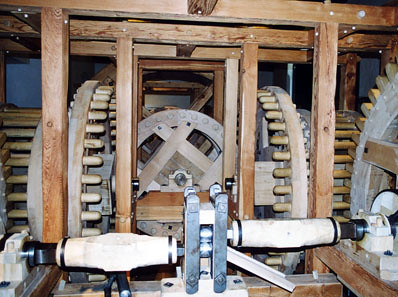
PREV ARTICLE
NEXT ARTICLE
FULL ISSUE
PREV FULL ISSUE
HANS VOGLER'S COIN ROLLING MILL
An article by Ursula Kampmann in the January 17, 2013 issue of CoinsWeekly discusses the history of the rolling mill, a machine which revolutionized minting. Specifically, it deals with a machine promoted by Hans Vogler. A reconstruction of such a mill is in the Hall Mint Museum in Hasegg Castle. Be sure to read the complete article!
-Editor

In the summer of 1562, three natives of Zurich teamed up to promote a technology that promised to yield substantial profits, a new rolling mill that allowed the production of better coins in less time with less effort. The partners of this consortium were Jakob Stanpfer, mint master in Zurich since 1561, who already made good use of this new minting machine, Rudolf Rordorf, an engineer who was engaged in the construction of rolling mills, Martin Rosentaler, another minting technician, Jakob Bluntschli, a carpenter – after all, the most important material of roller minting presses was wood – and Hans Vogler the Younger. Most likely every member of this consortium realized how important it was to present their own machine to the princes in a proper way – you see, the men from Zurich weren’t the only ones who had built a rolling mill. After the rack had gained currency in the second quarter of the 16th century, it was but a small step to the rolling mill. From the middle of the 16th century onwards, several so-called mint artists appeared on the scene who presented the European royal courts new machines for coining. They were all based on the rolling mill principle: a long metal strip ran through two rollers that ‘minted’ the strip with images on both sides. This new technology’s difficulty was in the detail: how to produce enough pressure needed to achieve the proper minting depth? How to cut the dies needed to achieve a circular imprint? How to make the upper roller run at exactly the same pace as the one for the reverse? Jakob Stampfer had solved most of these problems to a greater or lesser extent. Admittedly, when Ferdinand I, German emperor reigning between 1556 and 1564, provided him with the opportunity to present his minting machine, the ones responsible judged his technology as not yet mature because the machine needed considerable maintenance and reparations on a daily basis. Consequently, the emperor didn’t contract Stampfer but Rudolf Rordorf for installing a rolling mill although the latter hadn’t sampled his skills yet. That was probably the reason for a quarrel between Rordorf and Stampfer which became a matter for the Zurich Council in 1564. Stampfer and his sons had to manage all by themselves, since the other members of the rather short-lived ‘minting consortium’ likewise filed a suit against the mint master from Zurich. These conflicts needn’t concern us here, though. Let us turn to Rordorf and his rolling mill instead, which he promised the inhabitants of Tyrol to build. The cautious emperor had negotiated a contract with Rordorf that guaranteed the latter a reward of 1,500 gulden in case he successfully built and installed two minting machines. Exact numbers were laid down as to their projected mintage. The plan was that eight assistant would be able to mint 1,500 mark silver per week with the new machines. If only large-size silver coins were minted, that would have been more than 15,000 specimens, a huge number! But Rordorf’s promises turned out to be too optimistic.
To read the complete article, see:
The People of Zurich and their Money 8: a technology from Zurich captures the world
(www.coinsweekly.com/en/The-People-of-Zurich-and-their-Money The Numismatic Bibliomania Society is a non-profit organization promoting numismatic literature. See our web site at coinbooks.org. To submit items for publication in The E-Sylum, write to the Editor at this address: whomren@gmail.com To subscribe go to: https://my.binhost.com/lists/listinfo/esylum All Rights Reserved. NBS Home Page Contact the NBS webmaster 
|